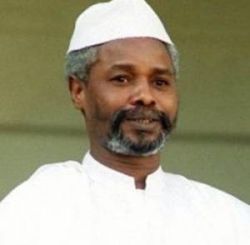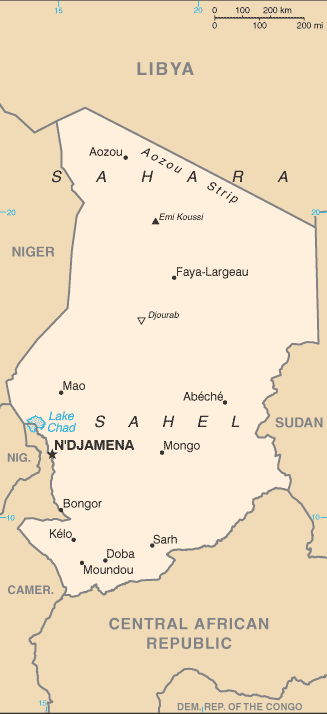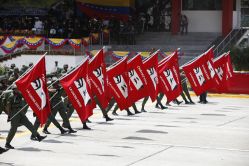
On Monday 30th May, a special tribunal in Dakar, Senegal, convicted former Chadian dictator, Hissène Habré on several criminal charges including crimes against humanity, committed during his brutal eight years in power. He was also convicted of war crimes, rape, sexual slavery, torture and kidnapping. He was sentenced to life imprisonment.
The regime of Hissène Habré (1982-1990) was one of the most heinous dictatorships in African history. The exact number of people who were killed, tortured or murdered during his reign of terror will probably never be known.Human Rights Watch estimates at least 40 000 people were murdered during his eight years in power and tens of thousands were kidnapped and tortured.

During the eight-month trial from 20 July 2015 to 11 February 2016, 93 witnesses testified to the crimes which were perpetrated by the regime of Habré. One after another they described the horror which they were subjected to at the hands of Habré’s secret police, the Documentation and Security Directorate (DDS). The DDS acted with complete impunity. No method of torture that was spared. Anything was permissible from beatings, whippings, waterboarding, electric shocks, rape and mutilations.
Some torture methods were particularly gruesome; forced asphyxiation on the exhaust pipe of a car, hot objects were used to burn genitals and other sensitive parts of the body, and in the method of “Arabatchar binding” arms and ankles of the victim were bound together behind the back, causing the chest to hyper-expand and arch. The victims were often left deformed and paralyzed.
Together with this, the court also heard of the deplorable conditions which prisoners were kept in, including overcrowded cells together with a lack of food and medical services. Prisoners were also kept in places without proper ventilation and lacking basic sanitary conditions. In addition to that prisoners were also forced to bury the dead. One witness testified that it was a relief to bury someone because it meant that more space would become available. That was the extent of the dehumanising effects the regime of Habré had on its victims.
Africa’s Pinochet
The case against Hissène Habré was the culmination of 26 years of relentless campaigning by survivors of his heinous regime and by human rights activists. However, the real reason why it was even possible to arrest Hissène Habré in the first place is to be found in the events which took place in Senegal four years ago. Habré fled to Senegal in 1990 when his regime was overthrown and settled in the upmarket suburb of Ouakam. Countless attempts by human rights activists to have him arrested by Senegalese authorities fell on deaf ears.
But the tide began to turn in March 2012. In the first wave of the recent revolutionary mass movements to sweep across many African countries, the corrupt former president of Senegal, Abdoulaye Wade, was voted out of office after mass mobilisations led by Y’en a Marre, a group of youth activists similar to Balai Citoyen in Burkina Faso. In an attempt to pacify the masses, his successor Macky Sall, introduced measures like reducing term limits and clamping down on corruption. As part of his attempts to “prettify” the regime, he introduced the principle of “universal jurisdiction” into the Senegalese law. This meant that a court in Senegal could hear the case against Habré even though the crimes were committed in Chad. It formed the basis for the creation of the Extraordinary African Chambers within the judicial system to prosecute the crimes committed between 7 June 1982 and 1 December 1990 in Chad. The conviction and sentencing of Hissène Habré is therefore a by-product of the mass mobilizations of the Senegalese masses.
The verdict against Hissène Habré has been 26 years in the making. Ever since he was overthrown by his former protegé, Idris Derby, in 1990, survivors of his regime have worked tirelessly to bring him to justice.
During his eight year rule as dictator of Chad between 1982 to 1990, Hissène Habré presided over one of the most reactionary and despotic regimes in African history. His reign of terror was often equated to that of former Chilean dictator Augusto Pinochet. Habré was also an extreme reactionary. He consolidated his power by putting in place a monstrous dictatorship through his National Union for Independence and Revolution (UNIR).
The UNIR created the special police, the DDS, who were responsible for the bulk of the atrocities committed by the regime. Like all despotic regimes, it kept meticulous records and it created an elaborate network of spies and reported on every minor detail to Habré himself. The DDS also had an armed wing called the Special Rapid Action Brigade (BSIR) which carried out arrests and the tortures in the detention centers.
“Quintessential desert warrior”
Hissène Habré came to power in Chad after overthrowing the regime of Goukouni Oueddeï. At the time, Chad was engaged in a fierce civil war in the north and south of the country. This was the legacy of French Imperialism which pitted tribes against each other and constructed arbitrary borders between a Muslim north and a Christian and animist south.
The country was also a battleground for a proxy war involving US Imperialism, French Imperialism and the regime of Muammar Gaddafi in Libya. Goukouni Oueddeï was an ally of Gaddafi and his overthrow was a boost for US Imperialism.
Gaddafi wanted to intervene militarily in Chad. Chad has a common border with Libya, Niger, Nigeria, Cameroon, the Central African Republic and Sudan. A successful campaign in Chad would have been detrimental to US Imperialism, especially in the Sudan which was a key US ally and the largest African recipient of American aid after Egypt at the time. Sudan was the only Arab country to stand by Egypt’s Anwar Sadat after he signed the Camp David Accords with Israel.

In 1980 Gaddafi invaded Chad and took control of more than half of its territory, and in 1981 he talked of a merger with Chad. That set the alarm bells off in Washington. These events also came on the back of the 1979 Iran hostage crisis and the new American president, Ronald Reagan’s desire to restore the prestige of US Imperialism.
Soon CIA director William Casey, ordered a campaign to supply weapons to the rebel fighters of Hissène Habré from the Sudan.The CIA would send supplies to Sudanese intelligence who would move them by train to Nyala, the former British Administration Headquarters in Darfur. From there Habré would pick them up and drive them across the border to Chad.
On 7 June 1982, thanks to American arms, Habré dealt the decisive blow when he captured the capital N’Djamena from the Gaddafi-backed Goukouni Oueddeï. That was only the start of US involvement in the proxy war. Massive stockpiles of weapons were delivered to the Habré regime. According to John Propst Blane, a U.S. ambassador in Chad from 1985 to 1988; “there were times that the N’Djamena Airport looked like Rhein-Main. I mean, I had C-5s and C-141s lined up on that runway. We were running an airlift in that place you wouldn’t believe.”(Quoted in Foreign Policy).
After a setback on the war in 1983, the US provided Habré with military trainers and portable surface-to-air missiles. It also deployed surveillance aircrafts, fighter jets and a tanker aircraft together with hundreds of military personnel to the Sudan to support the Habré regime. Reagan also approved $25 million in overt “emergency aid”.
But the decisive stage in the war came when the US started to supply Habré with Toyota pickup trucks mounted with 12.7 mm heavy machine guns. The mobility provided by the trucks dealt a heavy blow to the Libyan-backed forces. The successes scored by Habré in the so-called Toyota Wars endeared Habré to the Americans. The CIA called him the “quintessential desert warrior”. The Chadians received a reputation as some of the most rugged desert fighters in the world.
During all this time the Habré regime was directly supported and funded by US Imperialism. On 19 June 1987, in a statement by Ronald Reagan after having received Habré at the White House, Reagan congratulated Habré on his “stunning victories” and on how Chad had preserved “freedom”. Reagan spoke of his “admiration” for the Chadian regime: “Chad’s accomplishment is admired by the free world and will benefit all of Africa. By shoring up regional stability, Chad has helped its neighbors, who now can focus more of their energy and resources on country-building endeavors. Unfortunately, Chad and neighboring countries must remain vigilant against new threats, but Chad now knows it can count on its friends. For our part, the United States is committed to maintaining an appropriate level of security assistance to Chad.”
And while Habré was committing some of the most despicable crimes in Chad, the former US president painted an idyllic and rosy picture; “In our meetings, President Habre and I also looked to his country’s future economic and development needs. Years of warfare have left Chad’s economy in ruins. Reconstruction efforts have been set back by a cycle of severe drought, locust plagues, and other problems. For our part, the United States has tried to help to the degree possible in each emergency, yet the challenge remains great. Today we maintain an innovative, flexible program of development aid and budgetary support for Chad in an effort to move its fundamental economic situation.
Today President Habre emphasized that his government is committed to building a better life for the Chadian people, committed to reconstruction and economic growth. I assured him that we will continue to do our best, to work with France and other steadfast partners in the international effort to help reach President Habre’s laudatory goals.”
US Imperialism supported Habré personally right up to his overthrow by rebels on 30 November 1990. In fact, on that same night, the imperialists were still considering sending military aid to Habré. In the end, they decided against it. Instead they assisted Habré to flee the country. Habré reportedly drove his mercedes into a Lockheed L-100 Hercules transport plane which took him to Senegal where he lived comfortably for two decades. While Habré fled to Senegal, his regime simply melted away. The detention centers where the victims were kept were opened and thousands of inmates with scares, mutilated bodies and other cripples streamed into the streets of N’Djamena,
But for all the claims of personal bravery, Habré was also an extreme reactionary. When he came to power in the north, he immediately sent his forces to the south where he unleashed an unprecedented reign of terror. In September 1984 his regime destroyed whole villages, killing thousands of civilians including children and raping countless women and children.
The regime carried out a series of atrocities against other ethnic groups like the Hadjaras and the Zaghawa. In 1984 he launched a whole campaign of murder against the Hadjaras because he became wary of the popularity of his foreign affairs minister, Idriss Miskine.
The western media put great emphasis on the “extraordinary” nature of the case: Habré became the first head of state to be convicted of crimes against humanity by a court of another country. He was also the first head of state to be convicted of rape in his personal capacity and he became the first African head of state to be convicted of such crimes inside the African continent. But what the media rarely mentions and glosses over is the fact that the hideous regime of Habrè would not have survived the length of time it did without the direct and active support of US Imperialism.
When the media feels compelled to say something about US and French involvement, it does so only briefly and vaguely, like in this example from The Guardian:
“Many questions still remain unanswered, including several concerning the responsibility or complicity of western countries, such as France and the US, which actively supported Habré during the cold war years, turning a blind eye to his methods. Nevertheless, the trial brought the victims a long awaited moment of truth. This week’s verdict was the only way to bring closure. It sends a strong message to dictators everywhere. Africa has now set an example that others should follow.”
In a three paragraph statement, US Secretary of State John Kerry, only had this to say about US involvement: “As a country committed to the respect for human rights and the pursuit of justice, this is also an opportunity for the United States to reflect on, and learn from, our own connection with past events in Chad.”
After decades of horror in Chad in which victims were mutilated, raped, tortured and murdered at the hands of the what US Imperialism called the “quintessential desert warrior”, all John Kerry can do is release a cowardly statement calling for “the United States to reflect on”. This is the kind of thing the bosses say which makes your blood boil.
But while the US capitalists are “reflecting”, the American working class and youth are beginning to stir. The Bernie Sanders campaign has turned American politics upside down. No matter what happens next, the campaign has given a glimpse of the enormous revolutionary potential of the American working class. Together with the masses from Chad and Senegal, the American working class is fighting a common enemy and together with workers from the world, the American working class will overthrow the monstrous US Imperialism which has supported every despotic regime imaginable.

